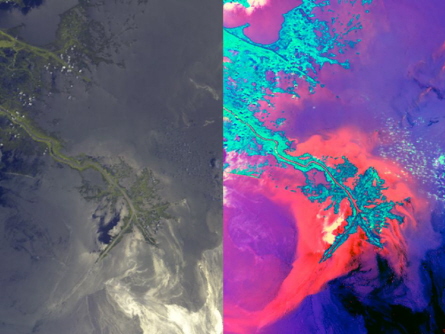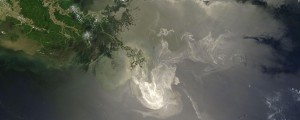Gulf oil finds many paths
Questions, and lots of oil, remain months after Gulf disaster
The hole at the bottom of the Gulf of Mexico may be plugged, but the problems aren’t over. There’s still a lot of oil in the water. Scientists are trying to find and remove it — and that’s a difficult process.
On April 20, the Deepwater Horizon drilling platform exploded. It sank two days later. A long pipe connected the drilling platform to an oil well buried deep under the Gulf of Mexico. When the platform sank, the pipe crumpled and oil began to flow into the water.
On July 15, engineers plugged a hole in the bottom of the Gulf of Mexico (the one that the Deepwater Horizon had drilled) that had by then been spewing oil into the water for months. This was no easy task: The hole was nearly a mile below the surface of the water, and plugging it required a cap weighing 75 tons, which is about as much as six large and empty school buses weigh.
Between April 20 and July 15, about 4.9 million barrels of oil escaped. That’s enough oil to fill more than 300 Olympic-sized swimming pools — and enough to set a new record for the worst oil spill in U.S. history.
Much of the oil has floated to the surface, but much has not — leaving many scientists scratching their heads. Where has it gone? Scientists, government officials, and representatives from BP, the company that was using the Deepwater Horizon, are trying to find out.
 |
|
The oil below. Researchers with the Woods Hole Oceanographic Institution used a submersible to see the oil blowout site up close. At about 1,100 meters deep (second image), the water is brown with oil. The first image is 1,000 meters deep
|
| R. Camilli/Woods Hole Oceanographic Institution |
In August, one federal organization reported that 17 percent of the oil was collected directly from the top of the well before it made it to the water. It also reported that another 5 percent was burned off and 3 percent was skimmed off the surface. Other scientists disagree: In government testimony on August 19, Ian MacDonald reported that only about 10 percent of the oil had been removed from the water, and that another 10 percent may have evaporated. MacDonald is an oceanographer at Florida State University who uses satellite data to study oil in the oceans and to study organisms that live underwater.
Many scientists are now studying the oil firsthand from research ships cruising around the Gulf. A team from the Woods Hole Oceanographic Institution in Woods Hole, Mass., reported in August that it had mapped a giant plume, or cloud, of oil floating beneath the surface. It is one of three or four plumes other groups have also reported.
This cloud was about as tall as a 50-story office building and more than a mile long. It was floating more than 3,000 feet beneath the surface, and the researchers say that’s mysterious. Oil usually floats on top of water, but there may be many of these plumes crawling along, deep underwater.
“We’re not sure why this plume set up at this depth,” Richard Camilli, a scientist from the Woods Hole team, told Science News. “But it appears to have persisted for at least several weeks or months. And it appears very stable, but we really don’t know why yet.”
Mix together oil and water, and you’ll notice that the oil immediately floats to the surface. And if you’ve ever tried to make salad dressing, you know that it’s difficult to keep oil and water mixed together. Oil floats on water because it is less dense. This means that if you have the same volume of oil and water, the water will weigh more.
 |
|
A collection of images taken May 24 from the NASA Terra spacecraft show oil approaching the Mississippi River delta. The left image shows brighter areas (bottom right) where sunlight glints more intensely, likely because of oil. The right side uses other
|
| NASA image gallery from the oil spill |
So why isn’t all the oil floating in the Gulf of Mexico? A mathematician named Roberto Camassa may have the answer. At his laboratory at the University of North Carolina at Chapel Hill, Camassa and his team have been studying how fluids flow and plumes form. He says that if oil droplets are small enough, it doesn’t matter that oil is less dense than water. Tiny droplets don’t float or sink — they move with the water.
“In our lab experiments, things mainly get trapped based on their density,” Camassa told Science News. The force of the oil coming from the hole in the bottom of the Gulf may have been powerful enough to create a kind of oil spray, and the tiny droplets in the spray don’t float.
Human beings who are trying to clean up the mess have an unusual tool that’s working with them. Some bacteria that live in the water digest the oil — and some scientists have already claimed seeing the results. In a study published August 24, scientists reported that one giant plume had already gone away, leaving behind a cloud of hungry microbes.

However, not everyone agrees that oil-eating critters are working so quickly. Other scientists say that plume may have drifted away due to currents. To better understand how these microbes work, scientists have set up “bug traps” — special beads that have BP oil on them. These beads will be anchored underwater in the Gulf, and scientists will periodically retrieve the beads and look for microbes.
We probably can’t trust tiny microbes to clean up the oil mess quickly. There’s a lot of work to do, and MacDonald says the damage may last for a long time. At the government hearing, he said oil that has not gone away could “remain potentially harmful for decades.” He also said that evidence of this giant oil disaster “will be detectable in the marine environment for the rest of my life.”
POWER WORDS (adapted from the Yahoo! Kids Dictionary and oilgasglossary.com)
plume A space in air, water or soil containing pollutants released from a specific point source.
density The mass per unit volume of a substance under specified conditions of pressure and temperature.
disperse To drive off or scatter in different directions.
microbe A minute life form; a microorganism, especially a bacterium.
offshore drilling Drilling for oil or gas from the floor of an ocean, gulf, or sea, usually on the outer continental shelf. A drilling unit for offshore operations may be a mobile floating vessel with a ship or barge hull, a semisubmersible or submersible base, a self-propelled or towed structure with jacking legs, or a permanent structure used as a production platform when drilling is completed.
Going Deeper:
Keep track of responses to the Deepwater Horizon disaster deepwaterhorizonsresponse.com
Raloff, Janet. 2010. “Most BP oil still pollutes the gulf, scientists conclude” Science News, August 19. http://www.sciencenews.org/view/generic/id/62415/title/Most_BP_oil_still_pollutes_the_Gulf%2C_scientists_conclude
Raloff, Janet. 2010. “Deep-sea oil plume goes missing,” Science News, Sept. 11. http://www.sciencenews.org/view/generic/id/62530/title/Deep-sea_oil_plume_goes_missing
Raloff, Janet. 2010. “Bug traps in gulf to use oil as bait,” Science News, August 25. http://www.sciencenews.org/view/generic/id/62583/title/Science_%2B_the_Public__%E2%80%98Bug_traps%E2%80%99_in_Gulf_to_use_BP_oil_as_bait
Ornes, Stephen. 2010. “The oily gulf,” Science News for Kids, May 31. http://sciencenews.org/view/generic/id/59809/title/FOR_KIDS_The_oily_Gulf







